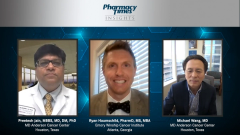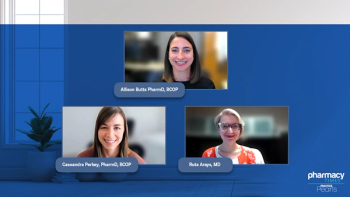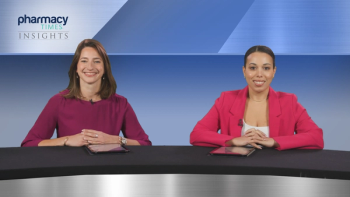
Exploring The Changing Landscape in MCL Treatment
Drs Preetesh Jain and Michael Wang exchange insights regarding the current and prospective treatment options for patients with Mantle Cell Lymphoma.
Episodes in this series

Ryan Haumschild, PharmD, MS, MBA: Well, I appreciate everything you all are doing there for mantle cell lymphoma. I remember watching you at 63rd ASH [American Society of Hematology] in December 2021 in Atlanta several months ago back. I think it's interesting to see you on the cutting edge. I think you're right; clinical trials are really changing the landscape, and you all have been a part of clinical trials over the last couple of years that have brought some innovative therapies to the market to better serve our patients. If you could, Dr Jain, give us a little bit of background for some of our viewers that maybe haven't been treating mantle cell lymphoma over the last decade. How has therapy changed over the last 10 to 5 years? If I had presented 10 to 5 years ago as a patient with mantle cell lymphoma, what would have I been treated with, and how has that changed now as we're looking at some of these innovative treatments?
Michael Wang, MD: Dr Jain is the perfect person to explain all this. Dr Jain is not only knowledgeable, but he's also a very good writer. He has published many good reviews that are being used and referenced by all in the field. Let's hear what he has to say.
Preetesh Jain, MBBS, MD, DM, PhD: Thank you. This is a very good question. In 1982, which was the first time Dr Dennis Weisenburger, a pathologist at City of Hope Comprehensive Cancer Center in Duarte, California et al described mantle cell lymphoma, at the time, it was clumped with the other lymphomas, and CHOP [cyclophosphamide, doxorubicin, vincristine, and prednisone] was the therapy which was given. Subsequently, rituximab came in. Then they added rituximab with CHOP therapy. Again, there has been tremendous development thanks to the efforts led by Dr Wang to get the BTK [Bruton tyrosine kinase] inhibitors into the treatment arena since 2013 onward. It was the first FDA [United States Food and Drug Administration] approval for ibrutinib in the United States, from the study published by Dr Wang in New England Journal of Medicine. That completely changed the landscape of treatment in mantle cell lymphoma. After ibrutinib, a BTK inhibitor, which is a targeted therapy, it's oral available treatment and it's already approved for relapsed/refractory mantle cell lymphoma. Subsequently, you have other second-generation and the newer generation of BTK inhibitors, which are orally available, easy to use, and patient-friendly. Even patients who are transplant-ineligible who are elderly with comorbidities are able to take those therapies because they are not suitable candidates for developing chemotherapy or chemoimmunotherapy.
The other change is that the long-term side effects of the chemoimmunotherapy are being seen now. We are seeing that patients are developing therapy-related myelodysplastic syndrome and second cancers with those agents. That's why the advent of BTK inhibitors clearly changed the landscape of the treatment. In 2020, Wang led another study, ZUMA-2, on the anti-CD19 CAR [chimeric antigen receptor] T-cell therapy brexucabtagene that is also FDA approved. That again changed the landscape, even in patients who are refractory to BTK inhibitors: that means patients who have not responded to these agents. Clearly, that has again changed the outcomes, and now, at the ASCO 2022 meeting, we will see the long-term follow-up of this therapy that has clearly changed the landscape. We are also into the era where we are combining these oral agents with the other oral agents, such as venetoclax. That is another study led by Dr Wang, the SYMPATICO study, the results of which will be presented. The safety run-in is already reported. Clearly, there is a plethora of combinations which are coming across, and treatment has clearly evolved. Again, these are dependent on the context and the availability of these agents as well as the availability of clinical trials. This is a very broad way to explain how the treatments have changed.
Michael Wang, MD: As Dr Jain has mentioned, the MD Anderson Cancer Center has been leading many of the national and international clinical trials in mantle cell lymphoma. Well, this is good for the field, but as a senior member in the clinical research, I also have the responsibility of working with the newer generation of investigators such as Dr Preetesh Jain, who is really a rising star. At this ASCO [2022], we have an educational session for mantle cell lymphoma at ASCO next week. This will be chaired by Dr Chan Cheah, a former MD Anderson Cancer Center fellow and now at the University of Western Australia in Perth, Australia; Dr Toby Eyre from Oxford University Hospitals NHS Foundation Trust in Great Britain; and Dr Anita Kumar from Memorial Sloan Kettering Center in New York. These new scholars are rising very fast, and please pay attention to them. They're going to bring tremendous progress to the field of mantle cell lymphoma.
Ryan Haumschild, PharmD, MS, MBA: I like how you talked about Dr Cheah and the next generation BTKis in Melbourne. I think there's a lot of data coming out there, and I love that international work that we're doing around mantle cell lymphoma. I feel like that's the best way to bring data forward is that diversity of ideas. Thank you, Dr Jain and Dr Wang, for going through that with me. I think it gives better context to where things are headed and for our patients. This is an exciting time, how can we turn mantle cell lymphoma into something that's a chronic disease where you have a long lifespan, especially if you're diagnosed in later stage of your life.
Transcript edited for clarity.
Newsletter
Stay informed on drug updates, treatment guidelines, and pharmacy practice trends—subscribe to Pharmacy Times for weekly clinical insights.


















































































































































































































